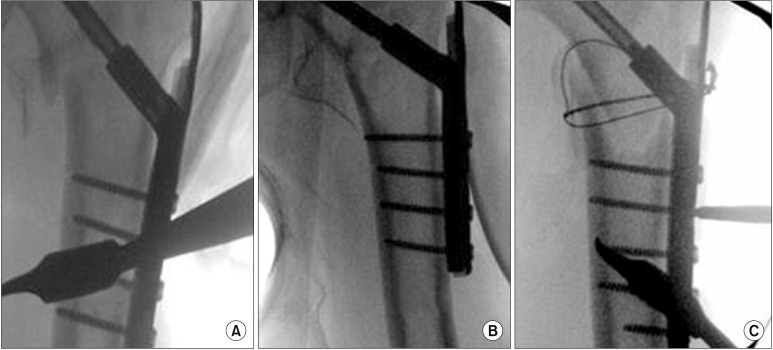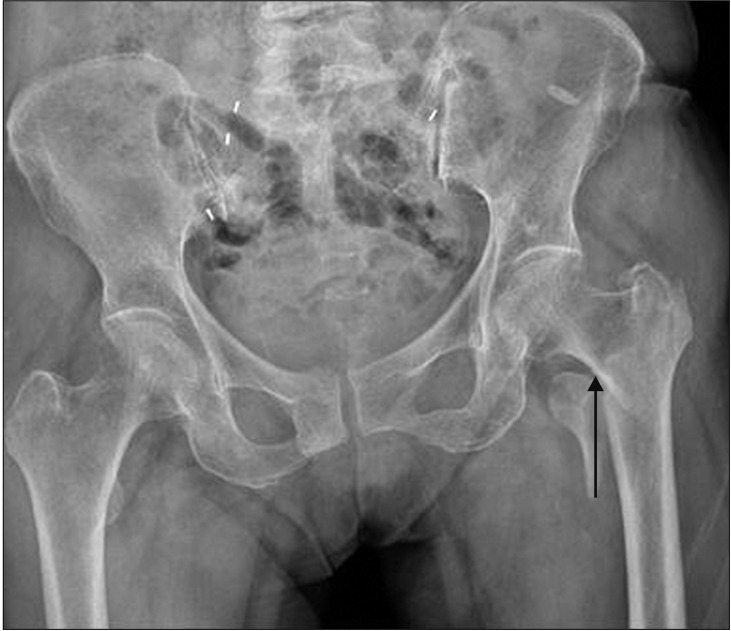Clin Orthop Surg.
2018 Sep;10(3):292-298. 10.4055/cios.2018.10.3.292.
The Effect of Positive Medial Cortical Support in Reduction of Pertrochanteric Fractures with Posteromedial Wall Defect Using a Dynamic Hip Screw
- Affiliations
-
- 1Department of Orthopaedic Surgery, College of Medicine, Daegu Catholic University, Daegu, Korea. cwk1009@hanmail.net
- KMID: 2418748
- DOI: http://doi.org/10.4055/cios.2018.10.3.292
Abstract
- BACKGROUND
We evaluated the radiological and clinical results of reduction using a dynamic hip screw according to the grade of medial cortical support in patients with AO Foundation and Orthopaedic Trauma Association (AO/OTA) classification type 31-A2 pertrochanteric fractures.
METHODS
We enrolled 100 patients with AO/OTA type 31-A2 fractures with displaced lesser trochanter fragments (length of the cortical area longer than 20 mm on the pelvis anteroposterior view). Patients with positive medial cortical support were assigned to group 1 (n = 28); neutral medial cortical support, group 2 (n = 42); and negative medial cortical support, group 3 (n = 30). Radiological evaluation was done by measuring the change in the femoral neck-shaft angle and sliding distance of the lag screw. Clinical outcomes of each group were compared by means of the walking ability score proposed by Ceder.
RESULTS
Group 1 showed significantly less changes in the femoral neck-shaft angle and shorter sliding distance than groups 2 and 3. Group 2 showed significantly less changes in the femoral neck-shaft angle and shorter sliding distance than group 3. Group 1 showed significantly higher walking ability scores than group 3 (p = 0.00). The use of trochanter stabilizing plates or fixation using wires for posteromedial wall defect resulted in no significant changes in terms of the femoral neck-shaft angle or sliding distance.
CONCLUSIONS
In the treatment of pertrochanteric fractures accompanied by posteromedial wall defect using a dynamic hip screw, reduction with negative cortical support should be avoided.
Figure
Cited by 2 articles
-
Comments on the Article “The Effect of Positive Medial Cortical Support in Reduction of Pertrochanteric Fractures with Posteromedial Wall Defect Using a Dynamic Hip Screw”: To the Editor
Su-Hyun Cho
Clin Orthop Surg. 2019;11(4):497-498. doi: 10.4055/cios.2019.11.4.497.Comments on the Article “The Effect of Positive Medial Cortical Support in Reduction of Pertrochanteric Fractures with Posteromedial Wall Defect Using a Dynamic Hip Screw”: In Reply
Myung Rae Cho, Won-Kee Choi
Clin Orthop Surg. 2019;11(4):499-499. doi: 10.4055/cios.2019.11.4.499.
Reference
-
1. Marmor M, Liddle K, Pekmezci M, Buckley J, Matityahu A. The effect of fracture pattern stability on implant loading in OTA type 31-A2 proximal femur fractures. J Orthop Trauma. 2013; 27(12):683–689. PMID: 23412511.
Article2. Knobe M, Gradl G, Ladenburger A, Tarkin IS, Pape HC. Unstable intertrochanteric femur fractures: is there a consensus on definition and treatment in Germany? Clin Orthop Relat Res. 2013; 471(9):2831–2840. PMID: 23389806.
Article3. Parker MJ, Pryor GA. Gamma versus DHS nailing for extracapsular femoral fractures: meta-analysis of ten randomised trials. Int Orthop. 1996; 20(3):163–168. PMID: 8832319.4. Anglen JO, Weinstein JN. American Board of Orthopaedic Surgery Research Committee. Nail or plate fixation of intertrochanteric hip fractures: changing pattern of practice. A review of the American Board of Orthopaedic Surgery Database. J Bone Joint Surg Am. 2008; 90(4):700–707. PMID: 18381305.5. Saudan M, Lubbeke A, Sadowski C, Riand N, Stern R, Hoffmeyer P. Pertrochanteric fractures: is there an advantage to an intramedullary nail? A randomized, prospective study of 206 patients comparing the dynamic hip screw and proximal femoral nail. J Orthop Trauma. 2002; 16(6):386–393. PMID: 12142826.6. Madsen JE, Naess L, Aune AK, Alho A, Ekeland A, Stromsoe K. Dynamic hip screw with trochanteric stabilizing plate in the treatment of unstable proximal femoral fractures: a comparative study with the Gamma nail and compression hip screw. J Orthop Trauma. 1998; 12(4):241–248. PMID: 9619458.
Article7. Jones JB. Screw fixation of the lesser trochanteric fragment. Clin Orthop Relat Res. 1977; (123):107.
Article8. Cho SH, Lee SH, Cho HL, Ku JH, Choi JH, Lee AJ. Additional fixations for sliding hip screws in treating unstable pertrochanteric femoral fractures (AO Type 31-A2): short-term clinical results. Clin Orthop Surg. 2011; 3(2):107–113. PMID: 21629470.
Article9. Chang SM, Zhang YQ, Ma Z, Li Q, Dargel J, Eysel P. Fracture reduction with positive medial cortical support: a key element in stability reconstruction for the unstable pertrochanteric hip fractures. Arch Orthop Trauma Surg. 2015; 135(6):811–818. PMID: 25840887.
Article10. Carr JB. The anterior and medial reduction of intertrochanteric fractures: a simple method to obtain a stable reduction. J Orthop Trauma. 2007; 21(7):485–489. PMID: 17762483.
Article11. Doppelt SH. The sliding compression screw: today's best answer for stabilization of intertrochanteric hip fractures. Orthop Clin North Am. 1980; 11(3):507–523. PMID: 7413172.12. Kyle RF, Gustilo RB, Premer RF. Analysis of six hundred and twenty-two intertrochanteric hip fractures. J Bone Joint Surg Am. 1979; 61(2):216–221. PMID: 422605.
Article13. Ceder L, Lindberg L, Odberg E. Differentiated care of hip fracture in the elderly: mean hospital days and results of rehabilitation. Acta Orthop Scand. 1980; 51(1):157–162. PMID: 6246706.14. Schumpelick W, Jantzen PM. A new principle in the operative treatment of trochanteric fractures of the femur. J Bone Joint Surg Am. 1955; 37-A(4):693–698. PMID: 13242603.
Article15. Clawson DK. Trochanteric fractures treated by the sliding screw plate fixation method. J Trauma. 1964; 4:737–752. PMID: 14225321.
Article16. Ecker ML, Joyce JJ 3rd, Kohl EJ. The treatment of trochanteric hip fractures using a compression screw. J Bone Joint Surg Am. 1975; 57(1):23–27. PMID: 1123368.
Article17. Jacobs RR, Armstrong HJ, Whitaker JH, Pazell J. Treatment of intertrochanteric hip fractures with a compression hip screw and a nail plate. J Trauma. 1976; 16(08):599–603. PMID: 957454.
Article18. Larsson S, Friberg S, Hansson LI. Trochanteric fractures: influence of reduction and implant position on impaction and complications. Clin Orthop Relat Res. 1990; (259):130–139.19. Steinberg GG, Desai SS, Kornwitz NA, Sullivan TJ. The intertrochanteric hip fracture: a retrospective analysis. Orthopedics. 1988; 11(2):265–273. PMID: 3357844.
Article20. Kim WY, Han CH, Park JI, Kim JY. Failure of intertrochanteric fracture fixation with a dynamic hip screw in relation to pre-operative fracture stability and osteoporosis. Int Orthop. 2001; 25(6):360–362. PMID: 11820441.
Article21. Hsu CE, Chiu YC, Tsai SH, Lin TC, Lee MH, Huang KC. Trochanter stabilising plate improves treatment outcomes in AO/OTA 31-A2 intertrochanteric fractures with critical thin femoral lateral walls. Injury. 2015; 46(6):1047–1053. PMID: 25890863.
Article22. Ingemarsson AH, Frandin K, Mellstrom D, Moller M. Walking ability and activity level after hip fracture in the elderly: a follow-up. J Rehabil Med. 2003; 35(2):76–83. PMID: 12691337.
- Full Text Links
- Actions
-
Cited
- CITED
-
- Close
- Share
- Similar articles
-
- Comments on the Article “The Effect of Positive Medial Cortical Support in Reduction of Pertrochanteric Fractures with Posteromedial Wall Defect Using a Dynamic Hip Screwâ€: In Reply
- Comments on the Article “The Effect of Positive Medial Cortical Support in Reduction of Pertrochanteric Fractures with Posteromedial Wall Defect Using a Dynamic Hip Screwâ€: To the Editor
- Additional Reduction Screw Fixation Technique for Pertrochanteric Hip Fractures: A Novel Method to Prevent Excessive Sliding in Cephalomedullary Nail Surgery
- Minimally Invasive Dynamic Hip Screw for stable Pertrochanteric Fracture
- Treatment of Unstable Interochanteric Femoral Fracture using Compression Hip Screw with additional Transfixations Screw




